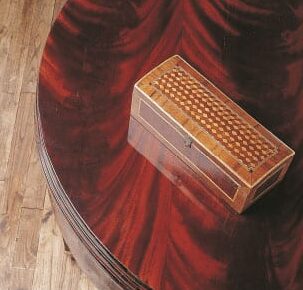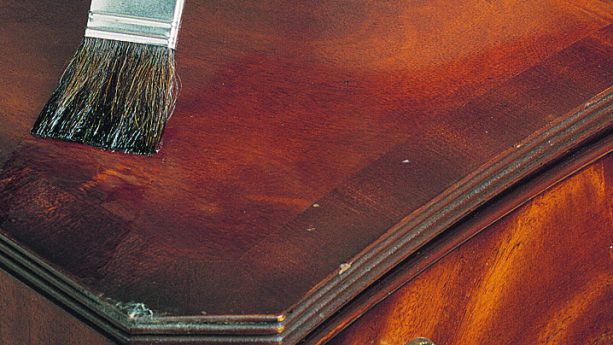How To French Polish Furniture


Step One – Preparation
Preparation of the surface to be polished is extremely important and to achieve the best results it is necessary to remove any slight imperfections that may not be noticeable under a varnish or wax finish. This may involve stripping off an old varnish with Libéron Fine Wood Stripper or removing a wax or oil with Libéron Wax and Polish Remover. Once stripped you will then need to rub the surface down with fine abrasive paper to obtain a smooth finish.
If the wood is open grained and a mirror like finish is required, the grain should be filled using a suitable grain filler. Alternatively, extra coats of polish may be applied and then cut back between coats with Libéron Ultra Fine Steel Wool (Grade 0000) until the grain has been filled.
Step Two – Materials
You will need:
- French Polish in your preferred colour
- Cotton Waste and Cotton Rag
- French Polishing Mops
Step Three – Making a French polishing rubber
French polish is applied using a French polishing rubber. The rubber is made by wrapping a piece of lint free cotton cloth around some cotton wadding or cotton waste. Place a handful of cotton wadding into the centre of the cotton rag, bring in the four corners of the rag and then twist to form a pear-shaped pad ensuring that the base of the pad is flat and free from creases or defects as shown. The size of the rubber can vary according to the user or the size of the job to be completed.
Step Four – How to hold the rubber
Hold the rubber in your hand keeping the bottom area flat and free from intrusions.
Step Five – Applying the product to the rubber
Load the rubber by pouring the French polish directly onto the cotton wadding. Do not pour the polish directly onto the face of the rubber. Bring the corners together and twist as before squeezing the polish to the face of the rubber. Any excess should be squeezed out before you commence polishing. If there is too much polish on the rubber this will cause ridges on the work. These ridges will then have to be rubbed down when the polish has dried and the process restarted from the smooth surface.
Step Six – How much polish is needed?
Too much polish – if lots of polish comes through the rubber when it is pressed on to the surface then too much polish has been applied.
Not enough polish – if barely any polish comes through the rubber when it is pressed on to the surface then not enough polish has been applied.
The correct quantity – the rubber should move freely on the surface but not leave lots of polish behind.
Step Seven – Fading Up
The first applications of polish are made by passing the rubber up and down working along the grain of the wood and slightly overlapping the previous pass. These first few coats will act as a seal ready for further coats and are known as fading up.
If the rubber feels as if it is dragging squeeze the sides very gently to push more polish onto the face or ease up on the pressure being applied to the rubber.
Step Eight – Bodying In
Further applications are made by using the rubber in a circular and figure of eight motion. The final pass in the sequence goes with the grain passing fairly quickly and lightly over the surface. Always finish the sequence along the grain.
The rubber should always be slid onto the work from one side and off the other during the polishing stroke. Placing the rubber on the work and then starting the stroke will create a mark which will be very difficult to remove. Likewise, the same problem will arise if the rubber is stationary on the surface. This is because the alcohol will immediately start to reactivate the previous coating.
After several applications the rubber may not slide so freely over the surface. To rectify this, add a drop of Libéron Boiled Linseed Oil to the base of the rubber ideally by dabbing it on with the tip of your finger. This will allow the rubber to move freely once more. Take care not to apply too much oil as this will leave a smearing effect on the surface and will have to be removed at the end.
Step Nine – Hardening
After every four or five applications the work should be left to harden for a couple of hours before applying further coats. We recommend lightly rubbing the surface down between coats with 320 grit abrasive paper or Libéron Ultra Fine Steel Wool (Grade 0000) to remove any blemishes.
Step Ten – Spiriting Off
Once a sufficient layer has been achieved on the surface spiriting off can commence to produce the final high gloss finish. A new rubber must be charged with French polish that has been thinned down with methylated spirit. Approximate ratio: two-parts French polish to one-part methylated spirit.
Apply this polish as before in a circular or figure of eight motion and again finish by going along the grain.
Finally pour a small amount of methylated spirit and a small amount of French polish at approximately a 50/50 split into the rubber and rub this up and down the work to remove any high spots. Move the rubber lightly and quickly over the surface to achieve a gloss finish.
Step Eleven – Burnishing
A French polish finish does not have to be a high gloss mirror finish every time, sometimes a softer level of sheen is required. To achieve this all you have to do is to allow the polished surface to harden for a few days then cut back the polish using Libéron Ultra Fine Steel Wool (Grade 0000) to remove any imperfections. Finally finish with a coat of Libéron Wax Polish Black Bison.
For a mirror finish you need to leave the French polish to fully harden for about a week to ten days then cut the surface back with Libéron Ultra Fine Steel Wool (Grade 0000) and remove any dust with a tack cloth. Next apply Libéron Burnishing Cream with a clean cotton cloth polishing vigorously and occasionally turning the cloth until the deep mirror finish is achieved.
Step Twelve – Carved Areas
For areas where a rubber cannot be used, i.e. carvings, a French polishing mop is recommended.
The basic steps and principles are still the same: apply thin coats of polish working with the grain where possible.
Never let the mop stick or stop on the surface.
Step Thirteen – Storage and Cleaning
To keep your rubber in good condition store it in an air-tight container with a small amount of methylated spirit. Your French polishing mop should be cleaned after use with methylated spirit and stored as above.
